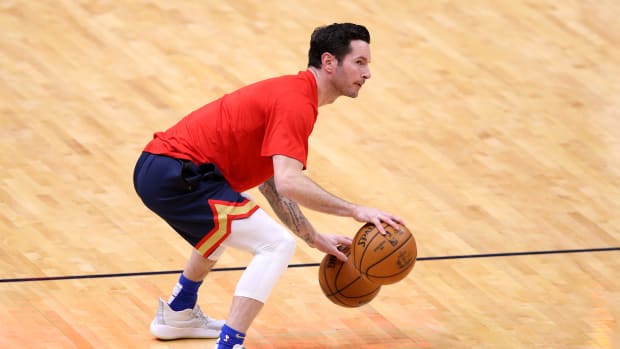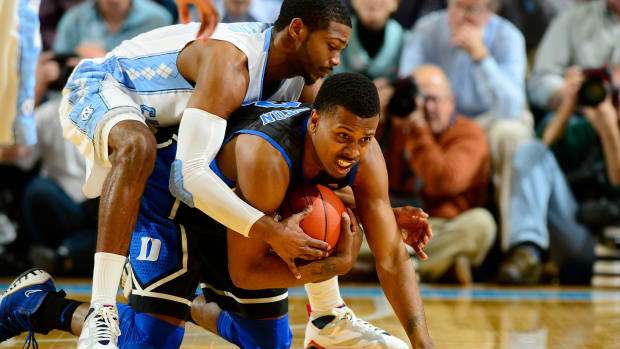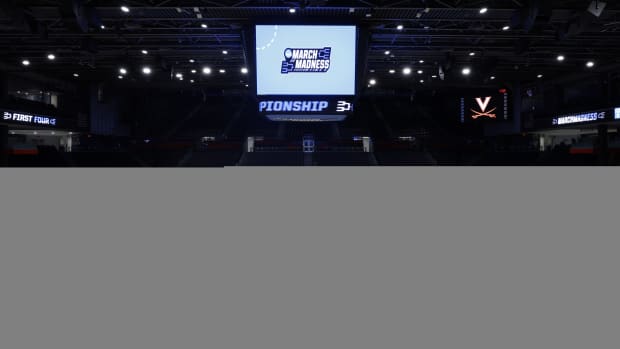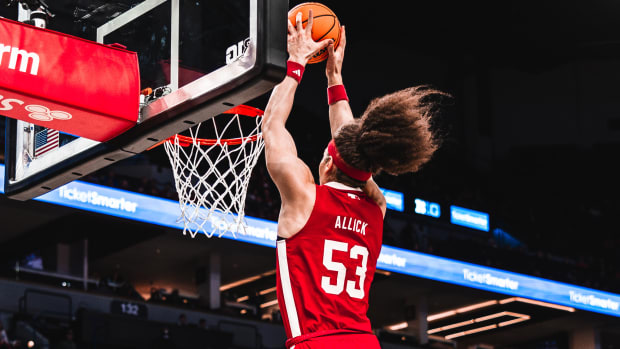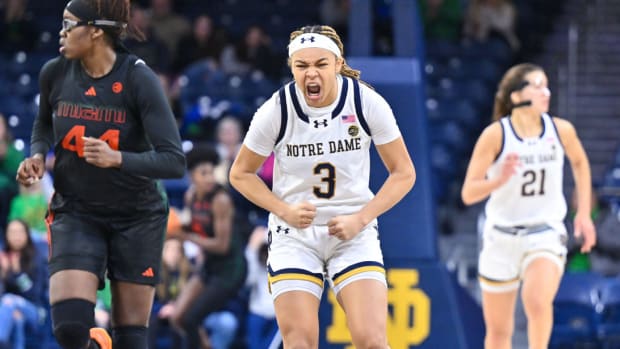Sprawling, Brawling Big 12 Rises as Men’s College Basketball’s Best Conference
Mark Pope walked up the loading dock ramp outside Oklahoma’s Lloyd Noble Arena on Tuesday night looking a bit haggard. An idling bus waited at the top of the ramp, ready to take Pope and his BYU Cougars team to the airport—it was time, at last, to get home to Utah. The 51-year-old Pope is a relentlessly positive guy, but in that moment, he seemed slightly deflated.
The No. 21 Cougars had just lost to the Sooners, 82–66. It was their largest margin of defeat since March 2022, dropping them to 16–6 overall and 4–5 in their new league, the Big 12. They had been on the road for five days straight, having played at West Virginia on Saturday and then traveled to Norman, Okla. They looked like a tired team against the Sooners, fading in the final 10 minutes.
Going from Appalachia to the Oklahoma prairie and eventually back home to the Wasatch range, this was a longer trek than what BYU was accustomed to in the more geographically contained West Coast Conference. And then there is the level of competition—the best college basketball conference in the country is appreciably better with the additions of BYU, the Houston Cougars, Cincinnati Bearcats and Central Florida Knights. After a national runner-up finish in 2019 (Texas Tech Red Raiders) and winning titles in ’21 (Baylor Bears) and ’22 (Kansas Jayhawks), then adding a ’21 Final Four program (Houston), the strong have gotten stronger. The expanded and enhanced Big 12 now is serving up bruises and road losses across three different time zones.
There is new blood. There is bad blood. There are bloodied teams littering the landscape. With a month to go in the regular season, everyone already has at least three league losses.

Houston coach Kelvin Sampson yells out to players during a game against the Texas Longhorns on Jan. 29, 2024.
Scott Wachter/USA TODAY Sports
There are chess matches between coaches. There are screaming matches with officials. Houston’s Kelvin Sampson and Baylor’s Scott Drew have been ejected already this month; if you thought the 68-year-old Sampson was too old or the Bible-thumping Drew was too pious to get run by the refs, think again.
There are howling fans and sassy pep bands and thumping sound systems creating feral atmospheres. Home teams are being elevated, visiting teams are being intimidated. Only one of the 14 teams has a winning league record on the road. (Texas is 3–2, but it’s also 1–4 in Austin.) Big 12 teams are winning 66.7% of their home league games, well above the 2023–24 national home rate of 59.5.
There is questionable excellence but quality depth. Ten Big 12 teams are in the top 40 of the NCAA NET rankings, twice as many as any other conference. Ken Pomeroy’s metrics rank 10 from the Big 12 in the top 35. Pomeroy currently rates the Big 12 as the top conference in the country for the third straight season. Most mock brackets project no fewer than nine from the league in the NCAA tournament.
There are so many tournament teams and so few easy nights. “We’re all just trying to stack wins,” Oklahoma coach Porter Moser says. “We’re all trying to go on one-game winning streaks.”
To Moser’s point: Baylor is the only Big 12 team currently enjoying something longer than a one-game winning streak. The Bears have captured three in a row—but they visit Kansas on Saturday for a national centerpiece game, with ESPN’s College GameDay on the scene. The Jayhawks haven’t lost a home game in more than a year.
What’s it like in the Big 12 right now? Ask Sampson, now in his 35th season as a college head coach, his Houston team ranked No. 1 by both the NET and Pomeroy.
Last year in the American Athletic Conference, Houston went 17–1. This year in the Big 12, the Cougars are 7–3.
“I feel like I’m a boxer in a 15-round fight, against the ropes, and they’re knocking the s--- out of me,” he says. “I came off the ropes OK, got back in the center of the ring, now I’m back on the ropes. We have a good team in a league full of good teams.”
Sports Illustrated caught three February conference games involving five teams in three towns across four days—a nascent rivalry, an old-school grudge match and a passing meeting between two programs occupying the same league for one season only. This was a slice of life in the sprawling, brawling Big 12.
Saturday, Feb. 3: Houston at Kansas
Students scurried down Naismith Drive through a spitting rain, heading toward the glowing furnace of fun that is venerable Allen Fieldhouse. (“The Saint Andrews of college basketball,” ESPN analyst Jay Bilas says.) The newest challenger to the Jayhawks’ Big 12 throne was in town. There was, for once, something for Kansas to prove.
Houston was favored by 1.5 points, a landmark event in and of itself—it was just the second time in coach Bill Self’s 21-year tenure that the Jayhawks were underdogs in their building. Unsurprisingly, given the program’s DNA, the Cougars have arrived in their new league unafraid. They look like every Sampson team—longer than tall, chiseled, grown men. They play like every Sampson team—athletic, fierce, relishing the game’s dirty work.
But Kansas has been breaking the spirit of confident visitors for decades. The fan base reliably rises to those rare occasions when it has to confront a perceived threat to their primacy. As competitors come and go within the Big 12, the Jayhawks endure and prevail.

Jayhawks forward KJ Adams dunks against Cougars guard Mylik Wilson on Feb. 3, 2024.
Jay Biggerstaff/USA TODAY Sports
“It’s kind of like going to Mecca,” says Sampson, who brought Oklahoma teams into The Phog from 1995–2006. “I don’t know how much longer I’ll do this, but I’m glad I got back to Allen Fieldhouse. Gallagher-Iba [Arena at Oklahoma State] and Hilton Coliseum [Iowa State] are the two other arenas that always stood out in the Big 12. But this is one of the great old barns in roundball.
“All due respect to the Dukes, the North Carolinas, the Kentuckys, but since 1995, the best program has been Kansas. They don’t have dips. Allen Fieldhouse does not allow for a rebuild. Allen Fieldhouse does not allow them to not be the best version of themselves they can be.”
On this day, the Jayhawks backed up Sampson’s words.
It was another tumultuous Saturday in the Big 12, with newcomers UCF and Cincinnati scoring upsets of Oklahoma and Texas Tech, respectively, and Drew earning the first ejection of his career at the Iowa State Cyclones. (Baylor athletic director Mack Rhoades subsequently was fined $25,000 for criticizing the officiating.) But Lawrence was, once again, the league’s center stage.
The walkway from the Kansas locker room to the court goes across a public concourse. Ushers clear a path for the Jayhawks, but the setup still offers fans an up-close opportunity to interact with their heroes as they go to and from the playing surface. Before the Houston game, freshman Johnny Furphy took time in the concourse to sign a few jerseys and pose for a few pictures.
Furphy has become an immediate fan favorite, thanks to his Australian accent and sweet shooting stroke. There were Furphy signs and Australian flags in the student section. Once the game started, there were escalating roars as he sank 6 of 7 field goals in a red-hot Kansas rout.
At the first media timeout, the Jayhawks had scored on every possession against the No. 1 defensive team in the nation and taken a 16–8 lead. During the timeout, the big screen flashed the score from the Kansas State Wildcats’ upset loss to the last-place Oklahoma State Cowboys, leading to another escalation in noise. It’s extremely hard to rattle Houston in any environment, but Kansas did.
“I don’t know that I’ve had a team execute better against a really good defensive team than we did in the first 10 minutes,” Self says. “We were on point.”
Kansas pushed the lead to 15 at halftime, still shooting at a blazing clip. Furphy had 14 points at intermission, hitting threes and throwing down a fast-break dunk on a feed from KJ Adams. He finished with 17 points and eight rebounds hinting at the potential lurking within his 6’ 9” frame.
“Johnny, he’s a real guy,” Self said, and “real guy” is high praise from him. “He’s getting better all the time. He looked like he belonged out there today, in a situation that he’s never been in. I know there’s some competitive dudes over there in the Center for Competitive Excellence in Australia, but I don’t think there was anything like he had to go against today.”
After completing his media rounds, Furphy went back out onto the court and was greeted by a pair of friends wearing Kansas jerseys. It was a good day to be the fresh prince of Lawrence, when the shots are falling and the fans are adoring.
“The day was all about the Kansas program, the tradition here, Bill getting his team ready to play in this gym,” Sampson said. “We could have played better tonight, but excuse my French, they shot the piss out of it, now.
“Somebody made a mistake and told me we were actually favored in this game. That’s sacrilege. How is Kansas not favored in any game, especially here? They don’t need this crowd to be good, but this thing was set up for this kind of environment today. You challenged the Jayhawk pride, if you will, by telling them they’re not favored. … Their fans were special today.”

Jayhawks fans cheer prior to a game against the Cougars at Allen Fieldhouse on Feb. 3, 2024.
Jay Biggerstaff/USA TODAY Sports
Self said he did not know his team wasn’t favored. But he knows that his fan base felt called upon to help.
“I do think it adds something to the intensity when the fan base knows this could go wrong if we don’t play well,” he said. “I think our fans were more turned up today because they knew if we didn’t play well [Houston] could leave out of here happy.” But Self also sounded a note of caution: a trip west on I-70 to Kansas State was just 48 hours away. A Kansas team that had lost three straight away from The Phog quickly went from feeling the home court love to bracing for the most visceral road hate.
“I would think the atmosphere we play in Monday,” he said prophetically, “will be comparable to what Houston played in today.”
Monday, Feb. 5: Kansas at Kansas State
At 12:36 a.m., the TVs in O’Malley’s Alley started airing ESPN highlights of what had transpired a couple of hours earlier in the Octagon of Doom. Immediately, bar patrons erupted in a chant that was audible on the fog-shrouded streets of Aggieville, the primary bar area in Manhattan, Kan.
“F--- KU! F--- KU! F--- KU!”
Fueled by rivers of beer and $6 Belfast Bombs (Guinness, Hennessy and Bailey’s), Kansas State fans in O’Malley’s were still in a euphoric state after the Wildcats upset the despised visitors from Lawrence, 75–70, in overtime. The same traditional chant had resonated through Bramlage Coliseum (aka, the Octagon) several times during the game, to the disappointment of second-year K-State coach Jerome Tang. He’s tried to soften the tone—or at least eliminate the F bombs—from his fans toward their biggest rival.
“I heard it when I was walking out and I was not very happy,” Tang said. “We will get to where that’s not a thing.”
One area of progress that pleased Tang: The students did not rush the court. They were massed and ready in the final seconds of OT, but when K-State coaches signaled they wanted the fans to stay in the stands, the fans complied.
“We’re building an expectation that these are the games we’re going to win, and we’re going to be that kind of a program,” Tang said. “I never see them storm the court at Allen Fieldhouse, I never see them storm the court at Duke and Carolina. I don’t think there is any reason why, given time and the opportunity, that we can’t build that kind of a program here in Manhattan, Kansas.”

Kansas State fans pack Bramlage Coliseum for the in-state rivalry game against Kansas on Feb. 5, 2024.
Evert Nelson/The Capital-Journal/USA TODAY Network
Historically, Kansas State men’s basketball has been a successful program. Banners commemorate four Final Fours—but Kansas has quadrupled that number and has won four national championships to the Wildcats’ zero. The Jayhawks stand superior in every hoops metric.
Deeper than that, though, is the historic standing of the two schools, a classic dynamic that can be found in many states. Kansas State was founded first, in 1863, as the state’s land-grant college, but Kansas grew to greater academic prestige and claims the title as the state’s “flagship institution.” K-State was the agricultural school—hence Aggieville—and has the smaller enrollment. While Kansas courts an increasing number of out-of-state students, K-State is counter-programming against that.
“The school FOR Kansans,” read purple billboards in the Sunflower State.
You don’t have to be around for long to figure out how the two fan bases feel about each other.
“You can tell there’s some disdain between the universities,” said Kansas center Hunter Dickinson, who transferred in this season from Michigan.
The seeds of rivalry were planted ages ago and manifested most overtly in a basketball series that was first played in 1907. This was the 300th meeting, and it was an all-timer for the Wildcats. If it’s impossible to top last season’s result in the Octagon—when K-State ended a seven-game losing streak to KU by scoring the winning basket on an audacious lob dunk in overtime—well, this one at least came close.
The K-State students came careening down the steps toward the front rows as soon the doors to Bramlage opened, carrying their signs in the shape of Kansas that read, “We OWN this state.” They filled three big sections of lower-arena sideline seats opposite the team benches, a similar outlay of prime real estate to what Duke does in Cameron Indoor Stadium. The result: maximum volume and intensity—at least when Kansas comes to town.

Tang joins players with the student section after defeating Kansas on Feb. 5, 2024.
Evert Nelson/The Capital-Journal/USA TODAY Network
The Wildcats wobbled in on a four-game losing streak, the most disappointing being that loss at Oklahoma State on Saturday. But the Jayhawks were vulnerable themselves, having lost three straight road games and now trying to quickly refocus after the feel-good rout of Houston. What transpired is the stuff rivalries are made of.
Kansas took a two-point lead into halftime, anybody’s game. Furphy, fresh off his star turn two days earlier, had just two points on a transition layup on his way to four for the game—a freshman in an unfriendly atmosphere, his name becoming more prominent overnight on the opposing scouting report.
“People will get a book on anybody,” Self said. “With all the success he’s had, his book has grown.”
The Jayhawks started the second half at a sprint, though, getting out in transition and scoring the first nine points—including two for Furphy on a lob. The energy in Bramlage began to subside. But K-State regrouped and quickly fought back, with guards Tylor Perry and Cam Carter combining for eight straight points to tie the game. The battle was joined and the noise rose without cessation for the rest of the night. Neither team led by more than four points for the remainder of regulation.
After everything went Kansas’s way Saturday at home, the fates conspired against the Jayhawks on Monday on the road. Several Dickinson shots just lipped out. He inadvertently tipped in a rebound for two K-State points to tie the game late in regulation. Wildcats forward Arthur Kaluma scored his team’s final basket of regulation when an airball fell to him beneath the basket.
But in overtime, K-State required no luck to win. The Wildcats took the lead for good on a desperation drive by Perry that ended with him shooting a jackknife scoop around 7’ 1” Dickinson at the end of the shot clock, releasing the ball from near his knee and spinning it off of the backboard.

Perry jumps for a layup against Kansas on Feb. 5, 2024.
Evert Nelson/The Capital-Journal/USA TODAY Network
“My teammates tell me all the time I can’t jump over a phone book,” the 5’ 11” Perry said with a laugh. “So the best thing to do is try to get it a little higher off the glass, because I’m not jumping over anybody.”
A transfer from the North Texas Mean Green, Perry’s shooting stroke has been in hiding for much of the season—one of the reasons why K-State has struggled in league play. But in the past two games, he shot 9 of 19 from three, including a dagger on the possession after his circus scoop. His play will be vital down the stretch.
Beating Kansas was a vital résumé boost for K-State, which made a run to the NCAA tournament Elite Eight last year but is simply trying to get into bubble contention now. For the Jayhawks, they departed the Octagon with some glares exchanged between the two coaching staffs and a four-game road losing streak that jeopardizes a No. 1 NCAA seed.
“In this league, anybody in America that would have come here tonight and played them, it would have been a hard win with that crowd,” Self said.
Tang concurred: “If you have a home court advantage, it’s a plus-10 [points]. They might have been plus-15 tonight.”
Tuesday, Feb. 6: BYU at Oklahoma
There is no rivalry here. No feuding. Pope and Moser are two of the least contentious coaches in the game (though that’s not the same as least competitive), and their programs are two Big 12 ships passing in the night.
No, the feuding is elsewhere. In January, Tang accused Iowa State of positioning some of its student managers behind his bench in Hilton Coliseum and recording their timeout huddles, a Connor Stalions–esque espionage allegation that was angrily refuted by the Cyclones. Also in January, Texas Longhorns coach Rodney Terry ripped UCF players for making “horns down” hand signals after shocking the Longhorns in Austin. “Classless,” Terry declared.
BYU, in contrast, has gone out of its way to make nice with Texas, which is leaving the league after this season. When students wore T-shirts that spelled out “HORNS DOWN” to the game in Provo, Utah, last month, the school reacted as if they’d done something heinous—it made them remove the shirts or cover them up. That acquiescence led to stinging commentary from Gordon Monson in The Salt Lake Tribune: “BYU is too concerned about its image, too wrapped up in presenting a sweet-faced picture to outsiders, especially powerful outsiders who the Cougars mistakenly believe are paying close attention to what they do.”
So BYU’s arrival on the plains of Oklahoma did not spark anything near the heat felt in Lawrence and Manhattan. But that didn’t make the long Morgantown, W.Va., to Norman, Okla., to Provo trek easy.

Sooners forward Jalon Moore celebrates a basket against the Cougars on Feb. 6, 2024.
Alonzo Adams/USA TODAY Sports
BYU used some of the extra time on the road to do what BYU does—focus on faith. Since the Cougars do not practice or compete on Sundays, they spent some of that day attending a worship service in West Virginia in the morning and then spoke at a devotional in Oklahoma upon arrival. Using athletics as a vehicle to spread Mormon beliefs is part of the school’s mission.
Sooner Nation, meanwhile, spent much of Tuesday grieving the loss of their most famous fan. Country music star Toby Keith, a native of nearby Moore, Okla., had died at age 62. Keith was a fixture at Oklahoma sporting events, and the Noble Center baseline seat next to athletic director Joe Castiglione, often occupied by Keith, was on this night taken by one of Keith’s guitars.
After the game, Moser lifted a red solo cup in Keith’s honor, an homage to his most famous song.
“He became a true friend of mine,” Moser said. “He was Sooner Nation. I wish there was something stronger in this than water.”
Moser’s team came into this game having lost three of its last four, including a dispiriting loss at UCF after a rousing win at Kansas State.
“As high as we were leaving Manhattan,” Moser said, “we were that low leaving Orlando.”
The Sooners were leaking oil after an overachieving 10–0 start, with Big 12 reality slapping them in the face several times. But home court, a weary opponent and an excellent defensive game plan led Oklahoma to a victory it needed.
The Sooners played a drop coverage off BYU’s ball screens, refusing to leave the Cougars’ array of deadly three-point shooters and putting the game in the hands of point guard Dallin Hall and big man Fousseyni Traore. They scored 38 points, the rest of the team scored 28 and made just 4 of 19 threes.
The result was a Quad 1 win for Oklahoma, its third against four losses. For now, the Sooners are on track to grab their first NCAA bid since ’21 and their first under Moser—the coach who took Loyola Chicago to a Cinderella Final Four in ’18.
“We’re trying to get to the tournament,” guard Milos Uzan says. “None of [us] have been there. Moser knows what it’s like.”
It’s the Promised Land, the dream destination for every college basketball player. Count on this league having more bids than any other come Selection Sunday. Membership in the sprawling, brawling Big 12 will have its privileges, after all the bruises suffered along the way.






